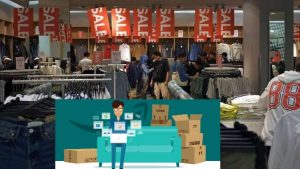
Urban shoppers seem to be tightening their purse strings when it comes to in-store purchases. People are sticking to need-based buying and that’s led to lower footfall and tepid conversion rates for brick-and-mortar retailers in the pre-Diwali weekend. Small traders seem to be hit the hardest: Some have reported a fall of 25-50% in festive season sales. Many traders feel the deep discounting model of e-commerce companies such as Amazon and Flipkart is hurting their business. Traffic in-store at malls across Mumbai, Delhi, Chennai and Bangalore has reportedly hit a new low.
No doubt, there is a chance of India entering into vicious cycle of economic slowdown and recession! But, concluding the same on basis of only organized retail will be unfair! Retail, as on date, has two main divisions – online (Ecommerce) and Offline! Offline again has two components – Organized and Unorganized! In all fairness, There is always a chance of retail sales being shifted from one mood to another among themselves – Ecommerce, Organized retail and unorganized retail! The position will be clear by this month end!
The festive season is well and truly on, for eastern India where Durga Puja is the centre of the festivities, some may argue that the major shopping season is over. For the rest of India, it would peak close to Diwali. For a substantial part of my career in retail, this used to be “the time of the year”. In Bengal, close to 45% of the annual sales target was parked to the period between September to November. Now, the festive buying story has changed, and traditional retail appears not to have responded well to the changing buying behavior of the Indian consumer. Influence of the Amazon’s and the Flipkart’s in inducing this change is unquestionable. However, I feel offline retail has itself to blame for the customers moving online.
Indian Retailers betting big on Private Labels to beat India’s Economic Slowdown
Consumers achieve bumper savings by purchasing unwanted products. The festival begins once the inauspicious period – Pitru Paksha- gets over during when no major decisions are done by most communities in India. As such the festival is still almost one week away and bonuses have not been paid yet in the unorganized sector but the shopping must go on.
Here is perhaps the most definitive indication that The Indian economy is in slow down mode. Denial doesn’t remove the slowdown. Neilsen monitors retail off-take and they are saying that consumption is at a 7 year low. What’s more rural off-take for the quarter ended September 2019 is a quarter of last year and the North is particularly affected where volume growth is flat in Q3 2019.
Fashion and Beauty Retailer Nykaa set to become the next Billion Dollar Indian Company
This is more evidence that the slowdown is a demand problem correlated with lower incomes ( consumers are also moving to lower priced products ) while most of the measures announced by the finance ministry affect the supply side.To complete the circle we now need to address the demand side.
The festive season is well and truly on, for eastern India where Durga Puja is the centre of the festivities, some may argue that the major shopping season is over. For the rest of India, it would peak close to Diwali. For a substantial part of my career in retail, this used to be “the time of the year”. In Bengal, close to 45% of the annual sales target was parked to the period between September to November.
Now, the festive buying story has changed, and traditional retail appears not to have responded well to the changing buying behavior of the Indian consumer.
Influence of the #Amazon’s and the Flipkart’s in inducing this change is unquestionable. However, I feel offline retail has itself to blame for the customers moving online.
Organised retail in India commands only 12% market share of offline retail as per IBEF; this includes the likes of Reliance Retail, Shoppers Stop, Westside, Pantaloons, Future Retail and Max Fashion. The rest 88% is still with traditional retail. For people complaining about the deep discounting and predatory tactics adopted by e-tailers, the simple first step would be taking up the 10-year challenge and find out what they are doing differently.
Organised retail in India commands only 12% market share of offline retail as per IBEF; this includes the likes of RelianceRetail, ShoppersStop, Westside, Pantaloons, FutureRetail and MaxFashion. The rest 88% is still with traditional retail. For people complaining about the deep discounting and predatory tactics adopted by e-tailers, the simple first step would be taking up the 10-year challenge and find out what they are doing differently.